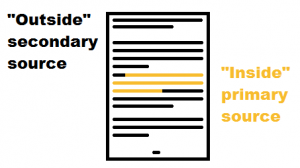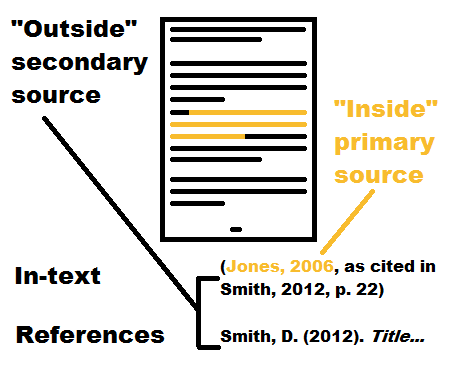Secondary sources
August 28, 2013

A book I’m reading has a great quote from a different source that I’d like to use. How do I reference that?
This is one of the most common referencing questions we hear. Fortunately, there’s a simple solution in all the common referencing styles (APA, MLA, Chicago).
The situation
Here’s the situation: you’re reading a book or journal article, and it quotes or cites another source. It has a citation, and the other source is listed in the reference list of the book / article.
You want to use this source, but who do you cite? The original author? The author that’s quoting them? Both authors?
First, some terminology:
- The “outside” source, the quoting source, is called the secondary source. In the picture at the top of this post, the secondary source is coloured black.
- The “inside” source, the quoted source, is called the primary source. In the picture, the primary source is coloured gold.
The primary source here is short – just a quotation, brief excerpt, or paraphrase. If the whole primary source is reproduced, it’s not a secondary source situation. Instead, it may be a chapter in an edited book, a republished work, or something similar.
Solution 1: Find the original
The best solution is to track down the original source. Most style guides recommend this, because you should always aim for the highest quality of sources. There’s always a possibility that the quoting author misunderstood or is misrepresenting the original. The context of the quotation could change its meaning. Finding the original sidesteps these problems.
The bibliographic details should be listed in the secondary source’s reference list. Google, Google Books or Scholar, or the library’s article databases can help you to find the source. See these guides on the Massey Library website:
- Finding books when you know the title or author
- Find a journal article when you have the title
- Find a newspaper article when you have the title
Solution 2: Secondary source citation
Sometimes, it’s just not possible to find the original. It might be out of print, not indexed online, or only available in the Scott Base Antarctic Research Library! If that’s the case, most referencing styles have a method to cite a secondary source.
In APA, both sources are cited in-text, with “as cited in” between them. The primary source comes first. It can be mentioned in the body of your writing:
The research conducted by Jones (as cited in Smith, 2012) demonstrated the…
Or it can go inside brackets:
The results (Jones, 2006, as cited in Smith, 2012) confirmed that…
The primary source (the “inside” quoted source) is not mentioned in the reference list. You haven’t seen that source yourself, so it only appears in the in-text citation. The secondary source is listed in the reference list, without mentioning the primary source at all.

Secondary sources in APA
MLA uses different language (“qtd. in” rather than “as cited in”) but otherwise uses the same approach.
Chicago style uses “quoted in” but the bibliographic details of both sources are listed in the footnote. See 14.273 of the Chicago Manual for the specifics.
Complications
Sometimes the secondary source cites several different primary sources at the same time:
The findings of Jones (2006), Merriweather (2007), and Tare (2004) also show that…
The APA method would look very cluttered in this circumstance:
(Jones, 2006, as cited in Smith, 2012; Merriweather, 2007, as cited in Smith, 2012; Tare, 2004, as cited in Smith, 2012)
The best option here is to move the primary authors outside the brackets, and describe them collectively rather than individually:
Several researchers (as cited in Smith, 2012) have confirmed…
Smith (2012) cites several pieces of research that verify the findings…
Used in the correct circumstances, secondary sources are a powerful tool in your referencing toolkit.

That’s a great posting, Damon – deals clearly and comprehensively with a common conundrum – i.e. you nailed it!
awesome explanation